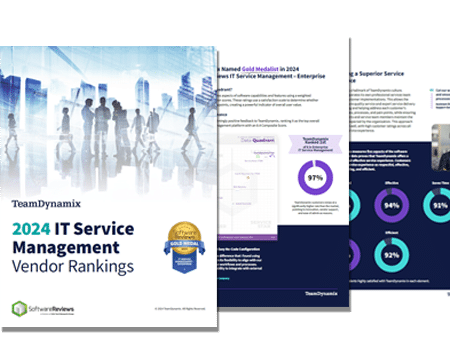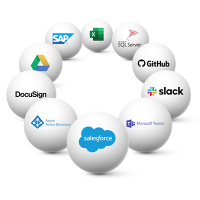
Paving the Way for Better IT Service with the Right ITSM Tool
The construction industry can be very volatile, with a high employee turnover rate due to seasonal fluctuations in the workforce. A key challenge for the

The Info-Tech ranking report offers a unique view of the market based entirely on in-depth customer interviews. Download the Info-Tech ITSM Quadrant and Customer Viewpoint report today.

We’ll show you some of our best situations and show you exactly how to execute them to get immediate results. The best part is, iPaaS tools often feature easy-to-use click and drag functionality, meaning you don’t need a dedicated employee building integrations and workflows.

System Integrators, Value Added Resellers, Technology Providers, and Buying Consortiums can benefit from a partnership with TeamDynamix.

The Info-Tech ranking report offers a unique view of the market based entirely on in-depth customer interviews. Download the Info-Tech ITSM Quadrant and Customer Viewpoint report to gain a better understanding of key vendor strengths and emerging market requirements.
IT Service Management platforms give IT leaders a leg up – helping them allocate resources and move toward strategic goals. With codeless, easy-to-use platforms specifically, organizations gain efficiency, lower their costs, and see higher customer satisfaction. IT service management (ITSM)provides so many benefits to IT departments that service management adoption in other areas of business is a growing trend – known as enterprise service management (ESM).
And with the latest software including automation and integration functionality, wasting time on repetitive ITSM tasks should be a thing of the past. While many organizations rate themselves as having a decent level of ITSM maturity, there is still a lot of room for improvement. Data from InformationWeek’s 2022 State of ITSM and ESM survey indicates that as we look forward, enterprise integration and automation stand to fundamentally change how organizations think about service management.
Finding: Low IT maturity levels could be costing teams time and money
Because ITSM has been around for quite some time, organizations have different levels of IT maturity. The study found that only 8% of organizations operate with a very high level of maturity in which their ITSM technology is fully optimized. At the same time, 44% of respondents said that they rely heavily on IT to administer ITSM systems. It’s important to recognize that the organizations that aren’t a part of that 8% wouldn’t have to put so much pressure on their IT teams if they upgraded their ITSM. Having a higher ITSM maturity means automating more tasks with codeless integration and operating software that is easier to use than the legacy systems in place. Thus, the percentage of people who say they “rely heavily” on IT to administer ITSM systems would greatly decrease, and time and money would be saved as a result.
The study also shows that 40% of organizations haven’t refreshed their ITSM technology in six or more years. If this continues, IT leaders are going to see the negative consequences of not treating ITSM like a priority- the largest one being the time and money they are losing.
Finding: Automation and workflow management lags
Without automation and workflow management your organization will likely struggle to achieve peak levels of efficiency – instead bogged down by integration backlogs and having to complete repetitive, mundane tasks. According to the study, more than half of organizations handle repetitive ITSM tasks manually and fewer than half have formal intake, prioritization and review processes in place to handle new work.
If you push automation and formal intake processes to the side, it’s likely to disrupt service delivery. For example, IT employees may hear service requests from different places, whether it’s a messaging system, someone directly telling them, a physical note, etc. When this happens, the most important projects and tickets cannot be prioritized, and the status of certain tasks becomes unclear which may lead to someone’s issue not being addressed.
Surprisingly, only 27% of organizations manage all ITSM, project portfolio management and integration and automation work on one platform. And considering how much automation can help, organizations should be taking more advantage of all that it can offer.
Finding: Organizational structure and processes are still loosely defined
Having strong organizational structure and processes ensures that all necessary tasks are getting completed. This is especially important within IT because there is much overlap between general IT projects, day-to-day ticketing and service management work. Giving different employees responsibility for different areas of business leads to a need for resource capacity planning to optimize workloads based on employee skill sets and availability.
51% of the organizations surveyed report high or very high maturity in IT service desk organizational structure and processes. The other 49% are at risk of confusion among employees and lack of transparency. Additionally, 58% say they do not have an ITSM framework in place (or are not sure if they have one). Out of those that do have one, the most used frameworks are ITIL v4 and v3, a hybrid framework based on principles of more than one other framework or COBIT. With such a large percentage of organizations not having mature organizational structures and processes, many are at risk of falling behind and wasting time due to confusion across teams. Defining structure and processes more strictly will increase efficiency and is something that should be given more of a focus.
Finding: Change management needs better control and visibility
Having solid change management processes in place is crucial to the improvement of an organization’s ITSM maturity. Without having good change management in place, something that was intended to create a positive outcome – the change – can instead create a significant number of IT problems and tickets. Poor change management may generate fallout when a change to one system affects other systems in unexpected ways.
Only 10% of ITSM practitioners say they operate with very high maturity in change management and fewer than a third of organizations integrate change management or create change records based on automation. Based on these numbers, organizations should invest in proper change management to gain better control and visibility while avoiding problems.
Finding: Self-service struggles without usable portals and knowledge bases
Self-service is a simple concept: have people find answers to their own questions instead of having them submit a ticket. This helps both the service team as well as the person searching for answers by saving time. Self-service models are shown to improve customer satisfaction as well as significantly reduce the per-incident cost for the IT team.
Self-service is widely recognized as being a valuable part of a business, with 81% of organizations reporting they have a knowledge base and 56% running a self-service portal. However, out of those with a knowledge base, only 5% say it is fully maximized and updated, and only 25% of organizations with a self-service portal say it is highly adopted and effective. Creating a knowledge base and self-service portal in the first place is a great step, but without continually updating the knowledge base to contain relevant and helpful information and implementing the service portal in a way that generates a lot of buy-in, neither will be able to serve their true purpose. This means that organizations need to put more focus on creating self-service experiences in a way that makes people want to utilize them.
Finding: ESM is extending ITSM gains, but mostly informally
Digital transformation is underway, and more than half of the organizations surveyed say it’s the number one trend they need to focus on tackling over the next few years. This means that IT teams need to be hyper-aware of how service platforms can integrate with other technologies that their company may be adopting. Tied to this trend is the trend of combining ITSM and PPM onto one single platform, as well as extending service management to many different areas of an organization through ESM.
Half of the organizations surveyed have extended their ITSM or ticketing platform and use it for managing work in other departments, but only 31% have a broader ESM program in place to leverage ITSM principles outside of IT. To keep up with digital transformation, organizations need to put more of an emphasis on a formal ESM platform.
Want to read more? Check out the full State of ITSM and ESM survey report here.

The construction industry can be very volatile, with a high employee turnover rate due to seasonal fluctuations in the workforce. A key challenge for the

A study from Information Week and TeamDynamix shows companies are looking to invest in IT Service Management (ITSM) software that is simple to administer and

When it comes to improving IT Service Management (ITSM) maturity, many organizations turn to ITIL – a framework that guides users through a process-based approach
TeamDynamix’s award-winning SaaS cloud solution offers IT Service and Project Management together on one platform with enterprise integration and automation.
[email protected]
(877) 752-6196
Contact Us
